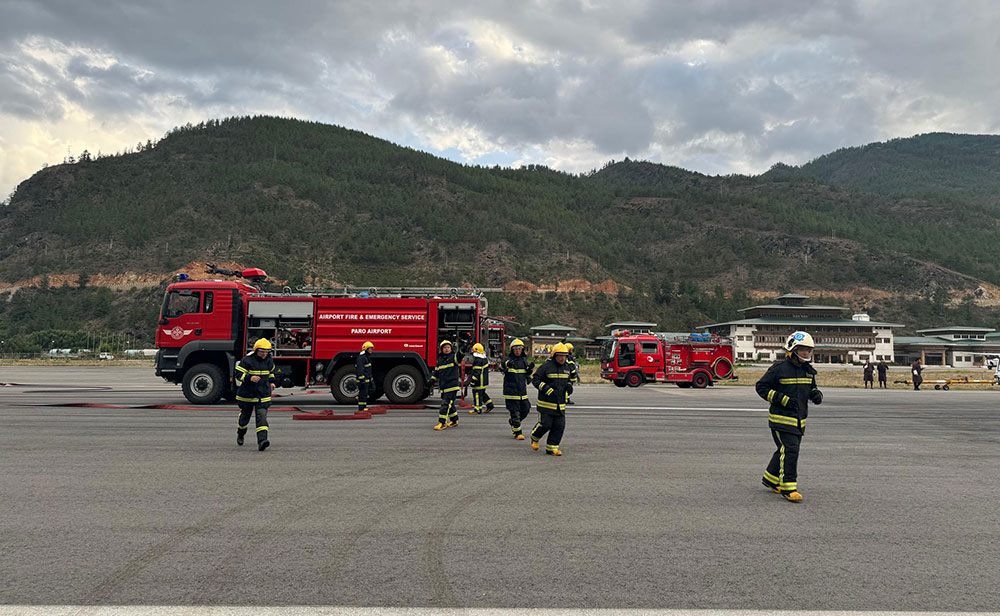Lhakpa Quendren
Paro—A Himalayan Airbus Havoc A320 carrying 160 passengers and four crew members departs from Suvarnabhumi International Airport in Bangkok, Thailand. The flight is scheduled to land on runway 33 at Paro International Airport at 4:50 pm on June 12.
Moments before landing, the aircraft encounters a microburst – an intense downdraft of air causing severe turbulence – causing a rough touchdown that bursts a tyre on the main landing gear.
This results in the aircraft veering sharply to the left, leaving the runway and skidding onto the adjacent grass. The rough landing partially dislodges the main undercarriage, severing hydraulic lines. The leaking hydraulic fluid ignites upon contact with the overheated undercarriage components, quickly leading to a fire on the aircraft’s left side, endangering both the wing and fuselage.

Full-scale emergency mock drill
The cabin crew responds promptly by initiating an emergency evacuation, directing passengers to exit via the escape slides on the right side of the aircraft. The passengers and crew gather safely on the grassy area next to the runway. However, several passengers sustain injuries due to the impact of the landing.
This scenario was simulated in a tabletop drill at Paro International Airport on June 12 to ensure the operational effectiveness of the procedures outlined in the Aerodrome Emergency Plan (AEP) by conducting a simulated passenger aircraft crash test.
The exercise saw about 70 officials from various agencies, such as the Bhutan Civil Aviation Authority (BCAA), airlines, police, Paro dzongkhag administration, hospitals, and desuups. They participated in a full-scale emergency mock drill after a detailed tabletop discussion.
The frictional full-scale emergency exercise (Himalayan Havoc), conducted once every two years, brings all stakeholders together in preparation to manage real-life emergency situations.
The director general of the air transport department, Karma Wangchuk, said it is essential to be prepared for unforeseen challenges. “Given that machinery hazards are unpredictable, the exercise is to mitigate potential risks,” he said.
To ensure a coordinated and effective response, trained personnel have specific roles assigned to manage emergencies. Not all airport staff participate in the evacuation process to prevent hindrances in execution.
Karma Wangchuk said that the two main risk factors at Paro International Airport for aircraft are strong winds and runway excursions. The department has plans to conduct a separate exercise for mid-air emergencies.
According to the department, the emergency exercise was not designed to test the capability of participating units, but to provide an opportunity to challenge the AEP and identify areas for improvement after the exercise was completed.
The recommendations, lessons, and observations from the exercise will be included in the final AEP manual.
The exercise is expected to enable the assessment of AEP’s command, control, and coordination at operational and incident control levels, which provides a platform for complex emergency operations in time-critical, resource-poor scenarios with multiple priorities.
It also provides each agency with the chance to join a multi-agency response to a simulated scenario, contribute to incident control, prioritise resources accurately, and showcase the optimal use of all available assets on scene, regardless of agency, ownership, or mission.
Trainer Peter McMahon (PhD) from Australia said the training significantly improves responses to incidents like aircraft crashes. “Such training brings together all the agencies for a common objective. This ensures that everybody is on the same page and understands their responsibilities,” he said.
He said Paro International Airport is considered one of the five most challenging airports in the world to land at due to factors such as terrain, wind conditions, and the length of the runway.
“We have a dedicated fire service at the airport, consisting of professional firefighters equipped with specialised equipment and trained for specific tasks to respond to emergencies,” he said, adding that the personnel are well-prepared for incidents like aircraft emergencies.
He said he had observed a significant improvement in the skills and knowledge of the firefighters compared to when he provided the same training in 2019. “I have witnessed a strong response in the exercise, which is highly valuable,” he said.
The last similar full-scale exercise was conducted in 2022 after being postponed since 2018 due to the pandemic.
Peter McMahon has provided innovative and immersive training experiences for air emergency services in over 20 countries worldwide.


